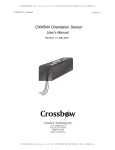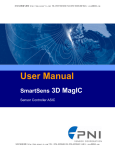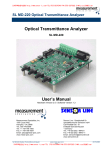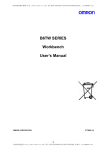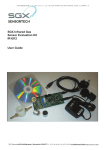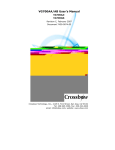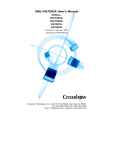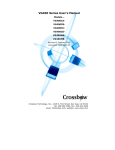Download RGA Series User`s Manual
Transcript
SUNSTAR传感与控制 http://www.sensor-ic.com/ TEL:0755-83376549 FAX:0755-83376182 E-MAIL:[email protected] RGA Series User’s Manual Models… RGA300CARevision A, January 2003 Document 7430-0015-01 Crossbow Technology, Inc., 41 Daggett Dr., San Jose, CA 95134 Tel: 408-965-3300, Fax: 408-324-4840 email: [email protected], website: www.xbow.com SUNSTAR自动化 http://www.sensor-ic.com/ TEL: 0755-83376489 FAX:0755-83376182 E-MAIL:[email protected] SUNSTAR传感与控制 http://www.sensor-ic.com/ TEL:0755-83376549 FAX:0755-83376182 E-MAIL:[email protected] ©2002-2003 Crossbow Technology, Inc. All rights reserved. Information in this document is subject to change without notice. Crossbow and SoftSensor are registered trademarks and DMU is a trademark of Crossbow Technology, Inc. Other product and trade names are trademarks or registered trademarks of their respective holders. SUNSTAR自动化 http://www.sensor-ic.com/ TEL: 0755-83376489 FAX:0755-83376182 E-MAIL:[email protected] RGA300CA User’s Manual SUNSTAR传感与控制 http://www.sensor-ic.com/ TEL:0755-83376549 FAX:0755-83376182 E-MAIL:[email protected] Table of Contents 1 Introduction.........................................................................2 1.1 1.2 2 Quick Start ..........................................................................4 2.1 2.1.1 2.1.2 3 GyroView Computer Requirements ...................................................4 Install GyroView................................................................................4 Connections..............................................................................................4 Setup GyroView......................................................................................5 2.4 Take Measurements ................................................................................5 DMU Details ........................................................................6 3.1 3.2 DMU Coordinate System.......................................................................6 Connections..............................................................................................6 3.3 3.4 Interface ....................................................................................................9 Measurement Modes...............................................................................9 3.5 3.5.1 Angle Mode........................................................................................9 BIT Processing ................................................................................10 Commands..............................................................................................10 Command List..................................................................................11 3.6 3.7 Data Packet Format...............................................................................13 Timing.....................................................................................................15 3.8 3.9 Temperature Sensor..............................................................................15 Analog Output .......................................................................................16 3.9.1 3.9.2 3.9.3 3.9.4 5 GyroView Software ................................................................................4 2.2 2.3 3.4.1 3.4.2 4 The RGA™ Series Motion and Attitude Sensing Units...................2 Package Contents ....................................................................................3 “Raw” Accelerometer Voltage........................................................16 Scaled Accelerometer Voltage.........................................................16 Scaled Rate Sensor Voltage.............................................................17 Pitch and Roll Voltages ...................................................................17 DMU Operating Tips .........................................................18 4.1 The “Zero” Command..........................................................................18 4.2 Mounting the DMU ..............................................................................18 Appendix A. Mechanical Specifications ..............................20 SUNSTAR自动化 http://www.sensor-ic.com/ TEL: 0755-83376489 FAX:0755-83376182 E-MAIL:[email protected] Doc.# 7430-0015-01 Rev. A Page i RGA300CA User’s Manual SUNSTAR传感与控制 http://www.sensor-ic.com/ TEL:0755-83376549 FAX:0755-83376182 E-MAIL:[email protected] 5.1 6 RGA300CA Outline Drawing.............................................................20 Appendix B. DMU Output Quick Reference ......................21 6.1 Analog Output Conversion..................................................................21 6.2 Digital Output Conversion...................................................................21 7 Appendix C. DMU Command Quick Reference .................22 8 Appendix D. Warranty and Support Information..............23 8.1 8.2 8.3 8.3.1 8.3.2 8.3.3 8.3.4 8.3.5 8.4 Customer Service ..................................................................................23 Contact Directory ..................................................................................23 Return Procedure...................................................................................23 Authorization ...................................................................................23 Identification and Protection...........................................................24 Sealing the Container ......................................................................24 Marking...........................................................................................24 Return Shipping Address.................................................................24 Warranty.................................................................................................24 SUNSTAR自动化 http://www.sensor-ic.com/ TEL: 0755-83376489 FAX:0755-83376182 E-MAIL:[email protected] Page ii Doc.# 7430-0015-01 Rev. A RGA300CA User’s Manual SUNSTAR传感与控制 http://www.sensor-ic.com/ TEL:0755-83376549 FAX:0755-83376182 E-MAIL:[email protected] About this Manual The following annotations have been used to provide additional information. X NOTE Note provides additional information about the topic. þ EXAMPLE Examples are given throughout the manual to help the reader understand the terminology. P IMPORTANT This symbol defines items that have significant meaning to the user M WARNING The user should pay particular attention to this symbol. It means there is a chance that physical harm could happen to either the person or the equipment. The following paragraph heading formatting is used in this manual: 1 Heading 1 1.1 Heading 2 1.1.1 Heading 3 Normal SUNSTAR自动化 http://www.sensor-ic.com/ TEL: 0755-83376489 FAX:0755-83376182 E-MAIL:[email protected] Doc.# 7430-0015-01 Rev. A Page 1 RGA300CA User’s Manual SUNSTAR传感与控制 http://www.sensor-ic.com/ TEL:0755-83376549 FAX:0755-83376182 E-MAIL:[email protected] 1 Introduction 1.1 The RGA™ Series Motion and Attitude Sensing Units This manual explains the use of the RGA300CA subsystem. The RGA300CA is a high performance MEMS gyro and tri-axial accelerometer subsystem. It is ideal solution for land vehicles where the majority of the motion control occurs on yaw rate axis. The system is designed to measure linear acceleration along three orthogonal axes and rotation rates around yaw axis. It uses three accelerometers and one angular rate sensor to make a complete measurement of the dynamics of your system. The Dynamic Measurement Unit (DMU) series are low power, fast turn on, reliable and accurate solutions for a wide variety of stabilization and measurement applications. All DMU products have both analog outputs and an RS-232 serial link. Data may be requested via the serial link as a single measurement or streamed continuously. The analog outputs are fully signal conditioned and may be connected directly to a data acquisition device. The Crossbow DMUs employ on board digital processing to provide application-specific outputs and to compensate for deterministic error sources within the unit. The DMUs accomplish these tasks with an analog to digital converter and a high performance Digital Signal Processor. The MEMS angular rate sensor is mounted with a z-sensitive axis, consist of vibrating ceramic plates that utilize the Coriolis force to output angular rate independently of acceleration. The three MEMS accelerometers are surface micro-machined silicon devices that use differential capacitance to sense acceleration. Solid-state MEMS sensors make the RGA300CA responsive and reliable. The accelerometer outputs can be used in one of the two ways. In GPS augmentation applications, the accelerometers can be used to estimate X, Y velocity by performing a single integration of the outputs. A second use for the acceleration signals is as an inclinometer. The acceleration sensors have DC response and therefore can accurately measure the gravity vector. When the vehicle is static or quasi-static, the accelerometer will indicate the roll and pitch of the vehicle. Typical applications for the system include vehicle guidance and control. Example equipment includes construction vehicles and land robots. Tall buildings, trees, and other obstructions make reliable GPS coverage challenging. Using the yaw rate sensor of the RGA300CA allows to overcome GPS outages. SUNSTAR自动化 http://www.sensor-ic.com/ TEL: 0755-83376489 FAX:0755-83376182 E-MAIL:[email protected] Page 2 Doc.# 7430-0015-01 Rev. A RGA300CA User’s Manual SUNSTAR传感与控制 http://www.sensor-ic.com/ TEL:0755-83376549 FAX:0755-83376182 E-MAIL:[email protected] 1.2 Package Contents In addition to your DMU sensor product you should have: • 1 CD with GyroView Software GyroView will allow you to immediately vie w the outputs of the DMU on a PC running Microsoft® Windows™. You can also download this software from Crossbow’s web site at http://www.xbow.com. • 1 Digital Signal Cable. This links the DMU directly to a serial port. Only the transmit, receive, power, and ground channels are used. The analog outputs are not connected. • 1 DMU Calibration Sheet The Digital Calibration Sheets contains the custom offset and sensitivity information for your DMU. The calibration sheet is not needed for normal operation as the DMU has an internal EEPROM to store its calibration data. However, this information is useful when developing your own software to correctly scale the output data. Save this page! • 1 DMU User’s Manual This contains helpful hints on programming, installation, valuable digital interface information including data packet formats and conversion factors. SUNSTAR自动化 http://www.sensor-ic.com/ TEL: 0755-83376489 FAX:0755-83376182 E-MAIL:[email protected] Doc.# 7430-0015-01 Rev. A Page 3 RGA300CA User’s Manual SUNSTAR传感与控制 http://www.sensor-ic.com/ TEL:0755-83376549 FAX:0755-83376182 E-MAIL:[email protected] 2 Quick Start 2.1 GyroView Software Crossbow includes GyroView software to allow you to use the DMU right out of the box and the evaluation is straightforward. Install the GyroView software, connect the DMU to your serial port, apply power to your unit and start taking measurements. 2.1.1 GyroView Computer Requirements The following are minimum capabilities that your computer should have to run GyroView successfully: • CPU: Pentium-class • RAM Memory: 32MB minimum, 64MB recommended • Hard Drive Free Memory: 15MB • Operating System: Windows 95, 98, Me, NT4, 2000 2.1.2 Install GyroView To install GyroView in your computer: 1. Put in CD “Support Tools”. 2. 3. Find the GyroView folder. Double click on the setup file. Follow the setup wizard instructions. You will install GyroView and a LabView 6 Runtime Engine. You need both. If you have any problems or questions, you may contact Crossbow directly. 2.2 Connections The DMU is shipped with a cable to connect the DMU to a PC COM port. 1. Connect the 15-pin end of the digital signal cable to the port on the DMU. 2. 3. Connect the 9-pin end of the cable to the serial port of your computer. The additional black and red wires on the cable supply power to the DMU. Match red to (+) power and black to (-) ground. The input voltage can range from 9-30 VDC at 200 mA for the RGA300CA. M WARNING Do not reverse the power leads! Applying the wrong power to the DMU SUNSTAR自动化 http://www.sensor-ic.com/ TEL: 0755-83376489 FAX:0755-83376182 E-MAIL:[email protected] Page 4 Doc.# 7430-0015-01 Rev. A RGA300CA User’s Manual SUNSTAR传感与控制 http://www.sensor-ic.com/ TEL:0755-83376549 FAX:0755-83376182 E-MAIL:[email protected] can damage the unit; Crossbow is not responsible for resulting damage to the unit. X NOTE The analog outputs fro m the DMU are unconnected in this cable. 2.3 Setup GyroView With the DMU connected to your PC serial port and powered, open the GyroView software. 1. GyroView should automatically detect the DMU and display the serial number and firmware version if it is connected. 2. If GyroView does not connect, check that you have the correct COM port selected. You find this under the “DMU” menu. 3. 4. 5. Select the type of display you want under the menu item “Windows”. Graph displays a real time graph of all the DMU data; FFT displays a fast-fourier transform of the data; Navigation shows an artificial horizon display. You can log data to a file by entering a data file name. You can select the rate at which data is saved to disk. If the status indicator says, “Connected”, you’re ready to go. If the status indicator doesn’t say connected, check the connections between the DMU and the computer; check the power; check the serial COM port assignment on your computer. 2.4 Take Measurements Once you have configured GyroView to work with your DMU, pick what kind of measurement you wish to see. “Graph” will show you the output you choose as a strip-chart type graph of value vs. time. “FFT” will show you a real-time fast Fourier transform of the output you choose. Let the DMU warm up for 30 seconds when you first turn it on. You should zero the rate sensors when you first use the DMU. Set the DMU down in a stable place. On the main control panel, enter a value into the “zero ave time” box. “50” will work well. Click the “Z” button. This measures the rate sensor bias and sets the rate sensor outputs to zero. The average time determines the number of samples for averaging. 1 unit equals 10 samples at the ADC sampling rate. For normal applications, your average time should be at least 20. The “zero” command is discussed more in “The ‘Zero’ Command” section. Now you’re ready to use the DMU! SUNSTAR自动化 http://www.sensor-ic.com/ TEL: 0755-83376489 FAX:0755-83376182 E-MAIL:[email protected] Doc.# 7430-0015-01 Rev. A Page 5 RGA300CA User’s Manual SUNSTAR传感与控制 http://www.sensor-ic.com/ TEL:0755-83376549 FAX:0755-83376182 E-MAIL:[email protected] 3 DMU Details 3.1 DMU Coordinate System The DMU will have a label on one face illustrating the DMU coordinate system. With the connector facing you, and the mo unting plate down, the axes are defined as: X-axis – from face with connector through the DMU. Y-axis – along the face with connector from left to right. Z-axis – along the face with the connector from top to bottom. The axes form an orthogonal right-handed coordinate system. An acceleration is positive when it is oriented towards the positive side of the coordinate axis. For example, with the DMU sitting on a level table, it will measure zero g along the x- and y-axes and +1 g along the z-axis. Gravitational acceleration is directed downward, and this is defined as positive for the DMU z-axis. The angular rate sensor is aligned with z-axis. The rate sensor measures angular rotation rate around z-axis. The direction of a positive rotation is defined by the right-hand rule. With the thumb of your right hand pointing along the axis in a positive direction, your fingers curl around in the positive rotation direction. For example, if the DMU is sitting on a level surface and you rotate it clockwise on that surface, this will be a positive rotation around the z-axis. Pitch is defined positive for a positive rotation around the y-axis (pitch up). Roll is defined as positive for a positive rotation around the x-axis (roll right). The angles are defined as standard Euler angles using a 3-2-1 system. To rotate from the body frame to an earth-level frame, roll first, then pitch, then yaw. 3.2 Connections The RGA300CA has a male DB-15 connector. The signals are as shown in Table 1. All analog outputs are fully buffered and are designed to interface directly to data acquisition equipment. See “Analog Output” for details. SUNSTAR自动化 http://www.sensor-ic.com/ TEL: 0755-83376489 FAX:0755-83376182 E-MAIL:[email protected] Page 6 Doc.# 7430-0015-01 Rev. A RGA300CA User’s Manual SUNSTAR传感与控制 http://www.sensor-ic.com/ TEL:0755-83376549 FAX:0755-83376182 E-MAIL:[email protected] Table 1. RGA300CA Connector Pin Out Pin Signal 1 RS-232 Transmit Data 2 RS-232 Receive Data 3 Positive Power Input (+) 4 Ground 5 X-axis accelerometer Analog voltage1 6 Y-axis accelerometer Analog voltage1 7 Z-axis accelerometer Analog voltage1 8 X-axis compensated acceleration2 9 Y-axis compensated acceleration2 10 Z-axis compensated acceleration2 11 NC – factory use only 12 Roll analog voltage3 13 Pitch analog voltage3 14 Yaw axis angular rate4 15 NC – factory use only Notes: 1. The accelerometer analog voltage outputs are the raw sensor output. These outputs are taken from the output of the accelerometers. 2. The compensated accelerometer analog outputs are scaled to represent G. These outputs are created by a D/A converter. 3. The pitch and roll analog outputs are scaled to represent degrees. These outputs are created by a D/A converter. 4. The rate sensor analog voltage outputs are scaled to represent degrees/sec. These outputs are created by a D/A converter. SUNSTAR自动化 http://www.sensor-ic.com/ TEL: 0755-83376489 FAX:0755-83376182 E-MAIL:[email protected] Doc.# 7430-0015-01 Rev. A Page 7 RGA300CA User’s Manual SUNSTAR传感与控制 http://www.sensor-ic.com/ TEL:0755-83376549 FAX:0755-83376182 E-MAIL:[email protected] The serial interface connection is standard RS-232. On a standard DB-25 COM port connector, make the connections per Table 2. Table 2. DB-25 COM Port Connections COM Port Connector Pin # Signal DMU Connector Pin # Signal 2 TxD 2 RxD 3 RxD 1 TxD 7 GND 4 GND* *Note: Pin 4 on the DMU is data ground as well as power ground. On a standard DB-9 COM port connector, make the connections per Table 3. Table 3. DB-9 COM Port Connections COM Port Connector Pin # Signal DMU Connector Pin # Signal 2 RxD 1 TxD 3 TxD 2 RxD 5 GND 4 GND* *Note: Pin 4 on the DMU is data ground as well as power ground. Power is applied to the DMU on pins 3 and 4. Pin 4 is ground; Pin 3 should have 9-30 VDC unregulated at 200 mA. If you are using the cable supplied with the DMU, the power supply wires are broken out of the cable at the DB-9 connector. The red wire is connected to VCC; the black wire is connected to the power supply ground. DO NOT REVERSE THE POWER LEADS. The analog outputs are unconnected in the cable we supply. The analog outputs are fully buffered and conditioned and can be connected directly to an A/D. The analog outputs can require a data acquisition device with an input impedance of 10kΩ or greater for DAC outputs and relatively higher impedance for raw analog outputs. SUNSTAR自动化 http://www.sensor-ic.com/ TEL: 0755-83376489 FAX:0755-83376182 E-MAIL:[email protected] Page 8 Doc.# 7430-0015-01 Rev. A RGA300CA User’s Manual SUNSTAR传感与控制 http://www.sensor-ic.com/ TEL:0755-83376549 FAX:0755-83376182 E-MAIL:[email protected] 3.3 Interface The serial interface is standard RS-232, 38400 baud, 8 data bits, 1 start bit, 1 stop bit, no parity, and no flow control. The DMU baud rate can be changed. To change the baud rate, follow this procedure: 1. 2. 3. 4. 5. Start with the DMU connected to the serial interface, with your software set to the default baud rate of 38400. Send the ASCII character “b” (62 hex) to the DMU. In a terminal program like Windows HyperTerminal or ProComm, this means simply type the letter “b”. The DMU is case sensitive. Now change the baud rate of your terminal software. Send the ASCII character “R”. The DMU will detect the character and automatically match the baud rate your software is using. Upon successful operation, the DMU will return the character “H” at the new baud rate. You can now use the DMU at the new baud rate. The new baud rate setting is not permanent; therefore, this process must be repeated after any power reset. 3.4 Measurement Modes 3.4.1 Angle Mode In angle mode, the RGA300CA will output the static pitch and roll angles along with the yaw angular rate and x, y, z acceleration information. The analog sensors are sampled, converted to digital data, temperature compensated, and scaled to engineering units. The digital data represents the actual value of the quantities measured. A calibration table for each sensor is stored in the DMU non-volatile memory. A single data packet can be requested using a serial poll command or the DMU can be set to continuously output data packets to the host. The data is sent as signed 16bit 2’s complement integers. The scaled sensor analog outputs are enabled in this mode. See the “Analog Output” section for a complete description of the analog outputs. To convert the acceleration data into G’s, use the following conversion: accel = data*(GR * 1.5)/215 where accel is the actual measured acceleration in G’s, data is the digital data sent by the DMU, and GR is the G Range for your DMU. (The data is scaled so that1 G = 9.80 m s -2 .) The G range of your DMU is the range of SUNSTAR自动化 http://www.sensor-ic.com/ TEL: 0755-83376489 FAX:0755-83376182 E-MAIL:[email protected] Doc.# 7430-0015-01 Rev. A Page 9 RGA300CA User’s Manual SUNSTAR传感与控制 http://www.sensor-ic.com/ TEL:0755-83376549 FAX:0755-83376182 E-MAIL:[email protected] accelerations your DMU will measure. For example, if your DMU uses a ±2 G accelerometer, then the G range is 2. To convert the angular rate data into degrees per second, use the following conversion: rate = data*(AR*1.5)/215 where rate is the actual measured angular rate in °/sec, data is the digital data sent by the DMU, and AR is the Angular rate Range of your DMU. The angular rate range of your DMU is the range of angular rates your DMU will measure. For example, if your DMU uses a ±100 °/s rate sensors, then AR range is 100. To convert the digital data to angle, use the following relation: angle = data*(SCALE)/215 , where angle is the actual angle in degrees (either pitch or roll), and data is the signed integer data output in the data packet, and SCALE is a constant. SCALE = 180° for roll and pitch. The roll angle is mathematically defined from – 180° to +180° . The pitch angle is mathematically defined from – 80° to +80° . 3.4.2 BIT Processing The BIT message in each packet provides comprehensive information into system health. The following information is supplied in the BIT byte fields of the data packet. The table 4 contains the actual bit definition present in the two-byte output BIT field in the angle mode data packet (see section 3.6 below). The description defines the bit’s active (1) position. Table 4 Bit Message Definition BIT Data Description Bit Location Calibration Table Temp Comp Table A bad calibration table in EEPROM has been detected. A bad temperature compensation table in EEPROM has been detected. Bit 6 Bit 7 3.5 Commands The DMUs have a simple command structure. You send a command consisting of one or two bytes to the DMU over the RS-232 interface and the DMU will execute the command. Note that the DMU commands are case sensitive! GyroView is a very good tool to use when debugging your own software. GyroView formulates the proper command structures and sends them over SUNSTAR自动化 http://www.sensor-ic.com/ TEL: 0755-83376489 FAX:0755-83376182 E-MAIL:[email protected] Page 10 Doc.# 7430-0015-01 Rev. A RGA300CA User’s Manual SUNSTAR传感与控制 http://www.sensor-ic.com/ TEL:0755-83376549 FAX:0755-83376182 E-MAIL:[email protected] the RS-232 interface. You can use GyroView to verify that the DMU is functioning correctly. GyroView does not use any commands that are not listed here. 3.5.1 Command List Command Ping Character(s) Sent R Response H Description Pings DMU to verify communications Command Polled Mode Character(s) Sent P Response none Description Changes data output mode to Polled Mode. DMU will output a single data packet when it receives a "G" command. Command Continuous Mode Character(s) Sent C Response Data Packets Description Changes data output mode to Continuous Mode. DMU will immediately start to output data packets in continuous mode. Data rate will depend on the measurement type the DMU is implementing (Raw, Scaled, or Angle). Sending a "G" will return DMU to Polled Mode. Command Request Data Character(s) Sent G Response Data Packet Description "G" requests a single data packet. DMU will respond with a data packet. Sending the DMU a "G" while it is in Continuous Mode will place the DMU in Polled Mode. SUNSTAR自动化 http://www.sensor-ic.com/ TEL: 0755-83376489 FAX:0755-83376182 E-MAIL:[email protected] Doc.# 7430-0015-01 Rev. A Page 11 RGA300CA User’s Manual SUNSTAR传感与控制 http://www.sensor-ic.com/ TEL:0755-83376549 FAX:0755-83376182 E-MAIL:[email protected] Command Calibrate Rate Sensor Bias Character(s) Sent z<x> Response Z Description Measure the bias on each rate sensor and set as the new zero. The DMU should be still (motionless) during the zeroing process. The argument of the command <x> is a single binary byte that tells the DMU how many measurements to average over. The units are 10 measurements per increment of <x>. For example, to average over 300 measurements, you would send the command z<30>, which in hex is 7A 1E. Description This queries the DMU firmware and will tell you the DMU type and firmware version. The response is an ASCII string. The exact string will vary according to the DMU type and version. Command Query Serial Number Character(s) Sent S Response Serial number packet Description This queries the DMU for its serial number. The DMU will respond with a serial number data packet that consists of a header byte (FF), the serial number in 4 bytes, and a checksum byte. The serial number bytes should be interpreted as a 32-bit unsigned integer. For example, the serial number 9911750 would be sent as the four bytes 00 97 3D C6. Command Request Auto Baud Rate Character(s) Sent b Response - Description This starts the auto baud rate detection process. This will allow you to change the DMU baud rate from its default. This change will not affect the default settings. SUNSTAR自动化 http://www.sensor-ic.com/ TEL: 0755-83376489 FAX:0755-83376182 E-MAIL:[email protected] Page 12 Doc.# 7430-0015-01 Rev. A RGA300CA User’s Manual SUNSTAR传感与控制 http://www.sensor-ic.com/ TEL:0755-83376549 FAX:0755-83376182 E-MAIL:[email protected] 1. Start with communications program and DMU at same baud rate. 2. 3. Send "b" to the DMU. Change the baud rate of your communications program. 4. Send "R" to the DMU. The DMU will respond with "H" at the new baud rate when a successful detection of the new baud rate is completed. Remember when sending z<x> command that each command is only two bytes long. For example, to tell the DMU to zero the rate sensors and average over 50 units, you would send two bytes 7A,32 (hex). 7A is the hex value of the ASCII “z” character, and 32 is the number 50 in hex. (The DMU averages over 10 samples for each unit in the z command.) 3.6 Data Packet Format In general, the digital data representing each measurement is sent as a 16-bit number (two bytes). The data is sent MSB first then LSB. In voltage mode, the data is sent as unsigned integers to represent the range 0 – 5 V. The data generally represents a quantity that can be positive or negative. These numbers are sent as a 16-bit signed integer in 2's complement format. The data is sent as two bytes, MSB first then LSB. The timer information and temperature sensor voltage are sent as unsigned integers. Each data packet will begin with a two -byte header (hex AA 55) and end with a two-byte checksum. The checksum is calculated in the following manner: 1. Sum all packet contents except header and checksum. 2. Divide the sum by hex FFFF. 3. The remainder should equal the checksum. The data packet contains two extra pieces of information: the part number, and the BIT word output. Please refer to section 3.4.2 for details about the BIT word processing. SUNSTAR自动化 http://www.sensor-ic.com/ TEL: 0755-83376489 FAX:0755-83376182 E-MAIL:[email protected] Doc.# 7430-0015-01 Rev. A Page 13 RGA300CA User’s Manual SUNSTAR传感与控制 http://www.sensor-ic.com/ TEL:0755-83376549 FAX:0755-83376182 E-MAIL:[email protected] Table 4. Data Packet Format Byte Angle Mode 0 Header (0xAA) 1 Header (0x55) 2 Roll Angle (MSB) 3 Roll Angle (LSB) 4 Pitch Angle (MSB) 5 Pitch Angle (LSB) 6 Yaw Rate (MSB) 7 Yaw Rate (LSB) 8 Acceleration X (MSB) 9 Acceleration X (LSB) 10 Acceleration Y (MSB) 11 Acceleration Y (LSB) 12 Acceleration Z (MSB) 13 Acceleration Z (LSB) 14 Time (MSB) 15 Time (LSB) 16 Temp Voltage (MSB) 17 Temp Voltage (LSB) 18 Part Number (MSB) 19 Part Number (LSB) 20 BIT (MSB) 21 BIT (LSB) 22 Checksum (MSB) 23 Checksum (LSB) X NOTE The header byte will likely not be the only AA byte in the data packet. You must count the bytes received at your serial port and use the checksum to ensure you are in sync with the data sent by the DMU. This is especially critical when using the continuous data packet output mode. SUNSTAR自动化 http://www.sensor-ic.com/ TEL: 0755-83376489 FAX:0755-83376182 E-MAIL:[email protected] Page 14 Doc.# 7430-0015-01 Rev. A RGA300CA User’s Manual SUNSTAR传感与控制 http://www.sensor-ic.com/ TEL:0755-83376549 FAX:0755-83376182 E-MAIL:[email protected] 3.7 Timing In some applications, using the DMU’s digital output requires a precise understanding of the internal timing of the device. The processor internal to the DMU runs in a loop - collecting data from the sensors, processing the data, and then collecting more data. The data is reported to the user through a parallel process. In continuous mode, the system processor activity is repeatable and accurate timing information can be derived based purely on the overall loop rate. The unit goes through three processes in one data cycle. First, the sensors are sampled. Second, the unit processes the data for output. Third, the unit actually transfers the data out; either over the RS-232 port, or onto the analog outputs. In the case of the analog output, the data is presented immediately on the analog output pins after the data processing step is over. A time tag is attached to each data packet. The time tag is simply the value of a free running counter at the time the A/D channels are sampled. The clock counts down from 65,535 to 0, and a single tick corresponds to 0.79 microseconds. The timer rolls over approximately every 50 milliseconds. 3.8 Temperature Sensor The DMU has an onboard temperature sensor. The temperature sensor is used to monitor the internal temperature of the DMU to allow for temperature calibration of the sensors. The sensor is specified to be within ±2% accurate over the DMU temperature operating range. The DMU reads and outputs the temperature sensor voltage in the digital data packet with 12-bit precision. The temperature sensor voltage is sent in the data packet scaled as: Vtemp (V) = data * 5/4096, where data is the 16-bit unsigned integer sent as the temperature information in the data packet. (The DMU uses two full bytes to express the data, but it is really scaled to 12 bits.) Calculate the temperature with the following calibration: T (°C) = 44.4 (°C/V) * (Vtemp (V) – 1.375 V), where Vtemp is the temperature sensor voltage sent in the DMU data packet. The DMU temperature sensor is internal to the DMU, and is not intended to measure the ambient temperature. The internal temperature of the DMU may be as much as 15°C higher than the ambient temperature. SUNSTAR自动化 http://www.sensor-ic.com/ TEL: 0755-83376489 FAX:0755-83376182 E-MAIL:[email protected] Doc.# 7430-0015-01 Rev. A Page 15 RGA300CA User’s Manual SUNSTAR传感与控制 http://www.sensor-ic.com/ TEL:0755-83376549 FAX:0755-83376182 E-MAIL:[email protected] 3.9 Analog Output The DMU provides six fully conditioned analog outputs – three accelerometer voltages and yaw rate sensor voltage and the pitch and roll analog voltages. The raw accelerometer sensor output is also available. The analog signals can be connected directly to an A/D or other data acquisition device without further buffering. The input impedance of your data acquisition device should be greater than 10 kΩ for the DAC outputs and relatively higher impedance for raw analog outputs. The circuit diagram for the raw accelerometer outputs (Pin 5, 6 and 7) is shown below: The DMU must be set to scaled sensor mode or angle mode to enable the scaled analog signals. 3.9.1 “Raw” Accelerometer Voltage The analog outputs from the accelerometers are taken directly from the sensor through a buffer. They are “raw” in the sense that they do not represent a calculated or calibrated value. You will need the zero bias point and scale factor given on the DMU calibration sheet to turn the analog voltage into an acceleration measurement. To find the acceleration in G’s, use the following conversion: accel (G) = (Vout(V) – bias(V))*sensitivity(G/V), where accel is the actual acceleration measured, Vout is the voltage at the analog output, bias is the zero-G bias voltage, and sensitivity is the scale factor in units G/volts. For example, if the x-axis of your accelerometer has a zero-G bias of 2.512 V, a sensitivity of 1.01 G/V, and you measure 2.632 V at the analog output, the actual acceleration is (2.632 V – 2.512 V)*1.01 G/V = 0.121 G. The "raw" accelerometer voltages will always be available on pins 5- 7. 3.9.2 Scaled Accelerometer Voltage The RGA300CA will create scaled analog accelerometer voltages on pins 8 – 10. These analog voltages reflect any calibration or correction the DMU applies to the accelerometer data. The analog voltage is created by an internal D/A converter using the digital data available to the DSP. The data is scaled to the range ±4.096 V with 12-bit resolution. You do not need to SUNSTAR自动化 http://www.sensor-ic.com/ TEL: 0755-83376489 FAX:0755-83376182 E-MAIL:[email protected] Page 16 Doc.# 7430-0015-01 Rev. A RGA300CA User’s Manual SUNSTAR传感与控制 http://www.sensor-ic.com/ TEL:0755-83376549 FAX:0755-83376182 E-MAIL:[email protected] use the calibration data that came with the DMU to use these outputs – the DMU is already applying the calibration stored in its EEPROM to the data. To find the acceleration in G’s, use the following conversion: accel (G) = GR * 1.5 * Vout(V) / 4.096 V, where accel is the actual acceleration measured, Vout is the voltage at the analog output and GR is the G range of your sensors. The G range is listed on the calibration sheet. For example, if your DMU has ±2 G accelerometers, GR is 2. 3.9.3 Scaled Rate Sensor Voltage The RGA300CA will output analog voltages representing the rate sensor measurement on pin 14. The analog outputs for the angular rate signals are not taken directly from the rate sensors; they are created by a D/A converter internal to the DMU. The output range is ±4.096V with 12-bit resolution. The analog data will represent the actual measured quantities, in engineering units, not the actual voltage at the sensor output. To convert the analog output to a sensor value use the following relation: rate = AR *1.5 * Vout (V) / 4.096 V, where rate is the actual measured rate in units °/s, AR is the angular rate range of your sensor and Vout is the measured voltage at the analog output. For example, if your DMU has a ±100 °/s rate sensor, and the analog output for that sensor is –1.50 V, the value of the measurement is 100 (°/s)*1.5*(1.50)/4.096 = 54.9 °/s. 3.9.4 Pitch and Roll Voltages The RGA300CA outputs the static pitch and roll angle analog voltages on pins 12 and 13. The analog pitch and roll outputs are created by the DMU internal D/A. The voltage output will be in the range ±4.096 V with 12-bit resolution. The output is scaled so that full scale is 90° for roll and 90° for the pitch. To convert the voltage to an actual angle, use the following conversion: angle = FA * Vout (V) / 4.096 V, where angle is the actual pitch or roll angle in degrees, FA is the full-scale angle and Vout is the analog pitch or roll voltage measured. FA is 90° for roll; FA is 90° for the pitch. The roll angle is mathematically defined from –180° to 180° , but the analog output has been scaled down to +/- 90°. The pitch angle is mathematically defined from - 80° to 80° . SUNSTAR自动化 http://www.sensor-ic.com/ TEL: 0755-83376489 FAX:0755-83376182 E-MAIL:[email protected] Doc.# 7430-0015-01 Rev. A Page 17 RGA300CA User’s Manual SUNSTAR传感与控制 http://www.sensor-ic.com/ TEL:0755-83376549 FAX:0755-83376182 E-MAIL:[email protected] 4 DMU Operating Tips 4.1 The “Zero” Command The “z<x>” command is used to zero the rate sensor outputs. This should be an essential part of your strategy in using the DMU effectively. The DMU rate sensors should therefore be zeroed to maintain the best accuracy. The rate sensors need to be zeroed more often when subject to large shocks or extremes of temperature. The DMU unit should be still during the zeroing process, but need not be level. You should let the DMU warm-up for 5 minutes before issuing the zero command. Zeroing the DMU measures the bias in the output of the rate sensors when the DMU is in a condition of zero angular rate, and uses these values of the biases as the new offset calibrations for the rate sensors. The zeroing command does not level the stabilized angle output. The DMU will average over a number of samples equal to ten times the value of the parameter passed with the “z<x>” command. For example, if you send the DMU the command “z<100>”, the DMU will average over 1000 samples. As a rule of thumb, each samp le will take 3 – 4 ms. A good value to start with for the averaging command is 200. You would send the two bytes 7A,C8 (hex). Remember that the DMU does not store the rate sensor zero calibration in non-volatile memory. If you cycle power to the DMU, it loses the zero calibration. Ideally, you would issue the zero command every time you power on the DMU. Also ideally, you would let the DMU warm up for 5 minutes before zeroing the rate sensors. If you find that the DMU zeroing algorithm does not work well in your particular application, please contact Crossbow to discuss possible options. 4.2 Mounting the DMU The DMU should be mounted as close to the center of gravity (CG) of your system as possible. This will minimize any “lever effect”. If it is not mounted at the center of gravity, then rotations around the center of gravity will cause the DMU accelerometers to measure acceleration proportional to the product of the angular rate squared and the distance between the DMU and the CG. The DMU will measure rotations around the axes of its sensors. The DMU sensors are aligned with the DMU case. You should align the DMU case as closely as possible with the axes you define in your system. Errors in alignment will contribute directly into errors in measured acceleration and rotation relative to your system axes. The sides of the DMU case are used as reference surfaces for aligning the DMU sensor axes with your system. SUNSTAR自动化 http://www.sensor-ic.com/ TEL: 0755-83376489 FAX:0755-83376182 E-MAIL:[email protected] Page 18 Doc.# 7430-0015-01 Rev. A RGA300CA User’s Manual SUNSTAR传感与控制 http://www.sensor-ic.com/ TEL:0755-83376549 FAX:0755-83376182 E-MAIL:[email protected] The DMU should be isolated from vibration if possible. Vibration will make the accelerometer readings noisy, and can therefore affect the angle calculations. In addition, if the magnitude of the vibration exceeds the range of the accelerometer, the accelerometer output can saturate. This can cause errors in the accelerometer output. The DMU case is not weather proof. You should protect the DMU from moisture and dust. SUNSTAR自动化 http://www.sensor-ic.com/ TEL: 0755-83376489 FAX:0755-83376182 E-MAIL:[email protected] Doc.# 7430-0015-01 Rev. A Page 19 RGA300CA User’s Manual SUNSTAR传感与控制 http://www.sensor-ic.com/ TEL:0755-83376549 FAX:0755-83376182 E-MAIL:[email protected] 5 5.1 Appendix A. Mechanical Specifications RGA300CA Outline Drawing SUNSTAR自动化 http://www.sensor-ic.com/ TEL: 0755-83376489 FAX:0755-83376182 E-MAIL:[email protected] Page 20 Doc.# 7430-0015-01 Rev. A RGA300CA User’s Manual SUNSTAR传感与控制 http://www.sensor-ic.com/ TEL:0755-83376549 FAX:0755-83376182 E-MAIL:[email protected] 6 Appendix B. DMU Output Quick Reference GR is the G-range of the accelerometers. For example, if your DMU has ±2 G accelerometers, GR = 2. RR is the rate range of the rate sensors. For example, if your DMU has ±100°/s rate sensors, RR = 100. 6.1 Analog Output Conversion Accelerometer Use sensitivity, offset from calibration sheet. Output is raw sensor voltage. Pin 5 Pin 6 X axis accelerometer, raw Y axis accelerometer, raw Pin 7 Z axis accelerometer, raw Rate Sensor Rate (°/s) = Vout(V) * RR * 1.5/4.096 Pin 14 Yaw rate sensor RR = 180 Accelerometer (Scaled Mode only) Accel (G) = Vout (V) * GR * 1.5/4.096 Pin 8 X axis accelerometer Pin 9 Pin 10 Y axis accelerometer Z axis accelerometer Roll, Pitch (Angle Mode only) Angle (°) = Vout (V) * FA/4.096 Pin 12 Roll Angle FA = 90 Pin 13 Pitch Angle FA = 90 Roll Output Defined to +/- 90 Pitch Output Defined to +/- 80 6.2 Digital Output Conversion Data is sent as 16-bit signed integer for all but Temperature. Temperature sensor data is sent as unsigned integer. Roll, Pitch (Angle Mode) Acceleration Accel (G) = data * GR * 1.5/215 Angle (°) = data * 180/215 Rate Temperature Rate (°/s) = data * RR * 1.5/2 15 Temperature (°C) = [(data * 5/4.096) – 1.375]*44.44 SUNSTAR自动化 http://www.sensor-ic.com/ TEL: 0755-83376489 FAX:0755-83376182 E-MAIL:[email protected] Doc.# 7430-0015-01 Rev. A Page 21 RGA300CA User’s Manual SUNSTAR传感与控制 http://www.sensor-ic.com/ TEL:0755-83376549 FAX:0755-83376182 E-MAIL:[email protected] 7 Appendix C. DMU Command Quick Reference Command (ASCII) Response Description R H Ping: Pings DMU to verify communications. P None Change to polled mode. Data packets sent when a G is received by the DMU. C None Change to continuous data transmit mode. Data packets streamed continuously. Packet rate is dependent on operating mode. Sending "G" stops data transmission. G Data Packet Get Data: Requests a packet of data from the DMU. z <0-255>* Z Calibrate and set zero bias for rate sensors by averaging over time. 1st byte initiates zeroing process. 2nd byte sets duration for averaging. Unit should be still during zeroing. b Change baud rate Autobaud detection. Send "b"; change baud rate; send "R" ; DMU will send "H" when new baud rate is detected. S ASCII String Query DMU serial number. Returns serial number as 32 bit binary number. v ASCII String Query DMU version ID string. Returns ASCII string. *Note: argument of command is sent as a single hex byte, not as an ASCII character. SUNSTAR自动化 http://www.sensor-ic.com/ TEL: 0755-83376489 FAX:0755-83376182 E-MAIL:[email protected] Page 22 Doc.# 7430-0015-01 Rev. A RGA300CA User’s Manual SUNSTAR传感与控制 http://www.sensor-ic.com/ TEL:0755-83376549 FAX:0755-83376182 E-MAIL:[email protected] 8 Appendix D. Warranty and Support Information 8.1 Customer Service As a Crossbow Technology customer you have access to product support services, which include: 8.2 • Single -point return service • Web-based support service • Same day troubleshooting assistance • Worldwide Crossbow representation • Onsite and factory training available • Preventative maintenance and repair programs • Installation assistance available Contact Directory United States: Phone: 1-408-965-3300 (7 AM to 7 PM PST) Fax: 1-408-324-4840 (24 hours) Non-U.S.: 8.3 Email: [email protected] refer to website www.xbow.com Return Procedure 8.3.1 Authorization Before returning any equipment, please contact Crossbow to obtain a Returned Material Authorization number (RMA). Be ready to provide the following information when requesting a RMA: • Name • Address • Telephone, Fax, Email • Equipment Model Number • Equipment Serial Number • Installation Date • Failure Date • Fault Description • Will it connect to GyroView? SUNSTAR自动化 http://www.sensor-ic.com/ TEL: 0755-83376489 FAX:0755-83376182 E-MAIL:[email protected] Doc.# 7430-0015-01 Rev. A Page 23 RGA300CA User’s Manual SUNSTAR传感与控制 http://www.sensor-ic.com/ TEL:0755-83376549 FAX:0755-83376182 E-MAIL:[email protected] 8.3.2 Identification and Protection If the equipment is to be shipped to Crossbow for service or repair, please attach a tag TO THE EQUIPMENT, as well as the shipping container(s), identifying the owner. Also indicate the service or repair required, the problems encountered, and other information considered valuable to the service facility such as the list of information provided to request the RMA number. Place the equipment in the original shipping container(s), making sure there is adequate packing around all sides of the equipment. If the original shipping containers were discarded, use heavy boxes with adequate padding and protection. 8.3.3 Sealing the Container Seal the shipping container(s) with heavy tape or metal bands strong enough to handle the weight of the equipment and the container. 8.3.4 Marking Please write the words, “FRAGILE, DELICATE INSTRUMENT” in several places on the outside of the shipping container(s). In all correspondence, please refer to the equipment by the model number, the serial number, and the RMA number. 8.3.5 Return Shipping Address Use the following address for all returned products: Crossbow Technology, Inc. 41 Daggett Drive San Jose, CA 95134 Attn: RMA Number (XXXXXX) 8.4 Warranty The Crossbow product warranty is one year from date of shipment. SUNSTAR自动化 http://www.sensor-ic.com/ TEL: 0755-83376489 FAX:0755-83376182 E-MAIL:[email protected] Page 24 Doc.# 7430-0015-01 Rev. A SUNSTAR传感与控制 http://www.sensor-ic.com/ TEL:0755-83376549 FAX:0755-83376182 E-MAIL:[email protected] SUNSTAR自动化 http://www.sensor-ic.com/ TEL: 0755-83376489 FAX:0755-83376182 E-MAIL:[email protected] SUNSTAR传感与控制 http://www.sensor-ic.com/ TEL:0755-83376549 FAX:0755-83376182 E-MAIL:[email protected] Crossbow Technology, Inc. 41 Daggett Drive San Jose, CA 95134 Phone: 408.965.3300 Fax: 408.324.4840 Email: [email protected] Website: www.xbow.com SUNSTAR自动化 http://www.sensor-ic.com/ TEL: 0755-83376489 FAX:0755-83376182 E-MAIL:[email protected] SUNSTAR传感与控制 http://www.sensor-ic.com/ TEL:0755-83376549 FAX:0755-83376182 E-MAIL:[email protected] SUNSTAR 商斯达实业集团是集研发、生产、工程、销售、代理经销 、技术咨询、信息服务等 为一体的高科技企业,是专业高科技电子产品生产厂家,是具有 10 多年历史的专业电子元器件 供应商,是中国最早和最大的仓储式连锁规模经营大型综合电子零部件代理分销商之一,是一家 专业代理和分銷世界各大品牌 IC 芯片和電子元器件的连锁经营綜合性国际公司,专业经营进口、 国产名厂名牌电子元件,型号、种类齐全。在香港、北京、深圳、上海、西安、成都等全国主要 电子市场设有直属分公司和产品展示展销窗口门市部专卖店及代理分销商,已在全国范围内建成 强大统一的供货和代理分销网络。 我们专业代理经销、开发生产电子元器件、集成电路、传感 器、微波光电元器件、工控机/DOC/DOM 电子盘、专用电路、单片机开发、MCU/DSP/ARM/FPGA 软件硬件、二极管、三极管、模块等,是您可靠的一站式现货配套供应商、方案提供商、部件功 能模块开发配套商。商斯达实业公司拥有庞大的资料库,有数位毕业于著名高校——有中国电子 工业摇篮之称的西安电子科技大学(西军电)并长期从事国防尖端科技研究的高级工程师为您精 挑细选、量身订做各种高科技电子元器件,并解决各种技术问题。 更多产品请看本公司产品专用销售网站: 商斯达中国传感器科技信息网:http://www.sensor-ic.com/ 商斯达工控安防网:http://www.pc-ps.net/ 商斯达电子元器件网:http://www.sunstare.com/ 商斯达微波光电产品网:HTTP://www.rfoe.net/ 商斯达消费电子产品网://www.icasic.com/ 商斯达实业科技产品网://www.sunstars.cn/ 传感器销售热线: 地址:深圳市福田区福华路福庆街鸿图大厦 1602 室 电话:0755-83370250 83376489 83376549 83607652 83370251 传真:0755-83376182 (0)13902971329 邮编:518033 E-mail:[email protected] 82500323 MSN: [email protected] QQ: 195847376 深圳赛格展销部:深圳华强北路赛格电子市场 2583 号 电话:0755-83665529 25059422 技术支持: 0755-83394033 13501568376 欢迎索取免费详细资料、设计指南和光盘 ;产品凡多,未能尽录,欢迎来电查询。 北京分公司:北京海淀区知春路 132 号中发电子大厦 3097 号 TEL:010-81159046 82615020 13501189838 FAX:010-62543996 上海分公司:上海市北京东路 668 号上海賽格电子市场 2B35 号 TEL:021-28311762 56703037 13701955389 FAX:021-56703037 西安分公司:西安高新开发区 20 所(中国电子科技集团导航技术研究所) 西安劳动南路 88 号电子商城二楼 D23 号 TEL:029-81022619 13072977981 FAX:029-88789382 SUNSTAR自动化 http://www.sensor-ic.com/ TEL: 0755-83376489 FAX:0755-83376182 E-MAIL:[email protected]































